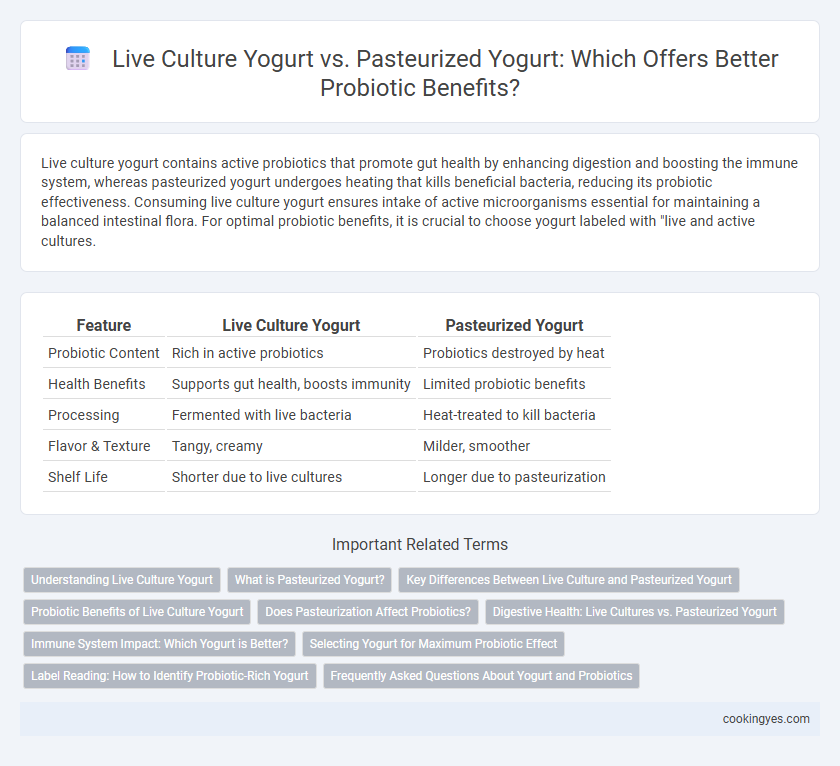Live culture yogurt contains active probiotics that promote gut health by enhancing digestion and boosting the immune system, whereas pasteurized yogurt undergoes heating that kills beneficial bacteria, reducing its probiotic effectiveness. Consuming live culture yogurt ensures intake of active microorganisms essential for maintaining a balanced intestinal flora. For optimal probiotic benefits, it is crucial to choose yogurt labeled with "live and active cultures.
Table of Comparison
| Feature | Live Culture Yogurt | Pasteurized Yogurt |
|---|---|---|
| Probiotic Content | Rich in active probiotics | Probiotics destroyed by heat |
| Health Benefits | Supports gut health, boosts immunity | Limited probiotic benefits |
| Processing | Fermented with live bacteria | Heat-treated to kill bacteria |
| Flavor & Texture | Tangy, creamy | Milder, smoother |
| Shelf Life | Shorter due to live cultures | Longer due to pasteurization |
Understanding Live Culture Yogurt
Live culture yogurt contains active probiotic bacteria such as Lactobacillus bulgaricus and Streptococcus thermophilus, which promote gut health and enhance digestion. Unlike pasteurized yogurt, which undergoes heat treatment that kills these beneficial bacteria, live culture yogurt retains its probiotic properties. Consuming live culture yogurt supports a balanced microbiome, improving immunity and nutrient absorption.
What is Pasteurized Yogurt?
Pasteurized yogurt undergoes heat treatment to eliminate harmful bacteria, which also reduces the number of beneficial probiotics present. While it remains safe to consume and provides essential nutrients like calcium and protein, pasteurization significantly diminishes the yogurt's live culture content. In contrast, live culture yogurt contains active probiotic bacteria such as Lactobacillus acidophilus and Bifidobacterium, promoting better gut health and enhanced digestive benefits.
Key Differences Between Live Culture and Pasteurized Yogurt
Live culture yogurt contains active probiotics that help improve gut health and boost digestion by maintaining a balanced microbiome. Pasteurized yogurt undergoes heat treatment that kills beneficial bacteria, significantly reducing its probiotic content and associated health benefits. Key differences include the presence of viable bacteria in live culture yogurt versus the inactive or absent probiotics in pasteurized varieties, making the former a superior choice for enhancing digestive wellness.
Probiotic Benefits of Live Culture Yogurt
Live culture yogurt contains active probiotics like Lactobacillus acidophilus and Bifidobacterium bifidum, which support digestive health and enhance immune function. Unlike pasteurized yogurt, live culture yogurt maintains these beneficial bacteria by avoiding heat treatment that kills probiotics. Regular consumption of live culture yogurt can improve gut microbiota balance, aid in nutrient absorption, and reduce symptoms of gastrointestinal disorders.
Does Pasteurization Affect Probiotics?
Pasteurization significantly reduces the number of live probiotics in yogurt by exposing it to high heat, which destroys beneficial bacteria like Lactobacillus and Bifidobacterium. Live culture yogurts contain active, viable probiotic strains that support gut health and enhance digestion, whereas pasteurized yogurts lack these live microorganisms due to thermal processing. Consuming live culture yogurt ensures maximum probiotic benefits that are diminished or absent in pasteurized products.
Digestive Health: Live Cultures vs. Pasteurized Yogurt
Live culture yogurt contains active probiotics like Lactobacillus acidophilus and Bifidobacterium, essential for enhancing gut microbiota and promoting digestive health. Pasteurized yogurt undergoes heat treatment that eliminates these beneficial bacteria, reducing its probiotic efficacy. Regular consumption of live culture yogurt supports improved digestion, immune function, and reduces symptoms of gastrointestinal disorders such as irritable bowel syndrome (IBS).
Immune System Impact: Which Yogurt is Better?
Live culture yogurt contains active probiotics such as Lactobacillus and Bifidobacterium strains, which enhance gut microbiota diversity and stimulate immune responses by promoting the production of anti-inflammatory cytokines. Pasteurized yogurt undergoes heat treatment that destroys these beneficial bacteria, significantly reducing its probiotic efficacy and immune-boosting potential. For optimal immune system support, consuming live culture yogurt is more effective due to its high concentration of viable probiotic organisms.
Selecting Yogurt for Maximum Probiotic Effect
Choosing live culture yogurt is essential for maximizing probiotic benefits, as it contains active bacteria such as Lactobacillus acidophilus and Bifidobacterium bifidum that support gut health and digestion. Pasteurized yogurt undergoes heat treatment that can kill these beneficial microbes, significantly reducing its probiotic effectiveness. Look for labels stating "contains live and active cultures" to ensure the yogurt provides potent probiotic strains for improved immune function and digestive balance.
Label Reading: How to Identify Probiotic-Rich Yogurt
Look for labels indicating "live and active cultures" to ensure the presence of viable probiotics in yogurt. Specific strains like Lactobacillus acidophilus and Bifidobacterium bifidum signal enhanced digestive benefits. Avoid yogurts that mention pasteurization post-fermentation, as this process kills beneficial bacteria, reducing probiotic content.
Frequently Asked Questions About Yogurt and Probiotics
Live culture yogurt contains active probiotic bacteria such as Lactobacillus acidophilus and Bifidobacterium, which support gut health and enhance digestion, unlike pasteurized yogurt where these beneficial microbes are destroyed during heating. Probiotic benefits in yogurt depend on the viability of these live cultures that survive stomach acid and colonize the intestines. Consumers frequently ask whether pasteurized yogurt offers similar digestive advantages, but only live culture yogurt provides the confirmed probiotic effects essential for improving immunity and balancing intestinal flora.
Live culture yogurt vs pasteurized yogurt for probiotic benefits Infographic

 cookingyes.com
cookingyes.com